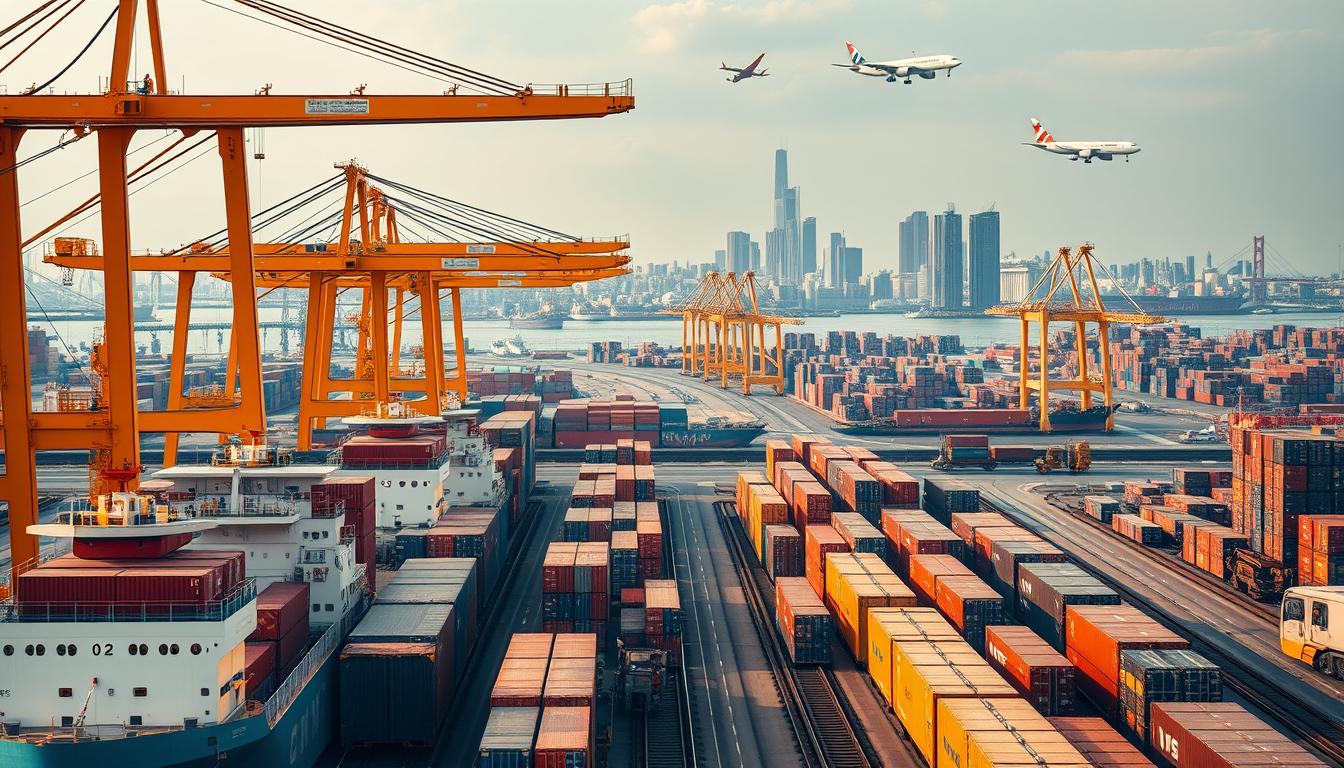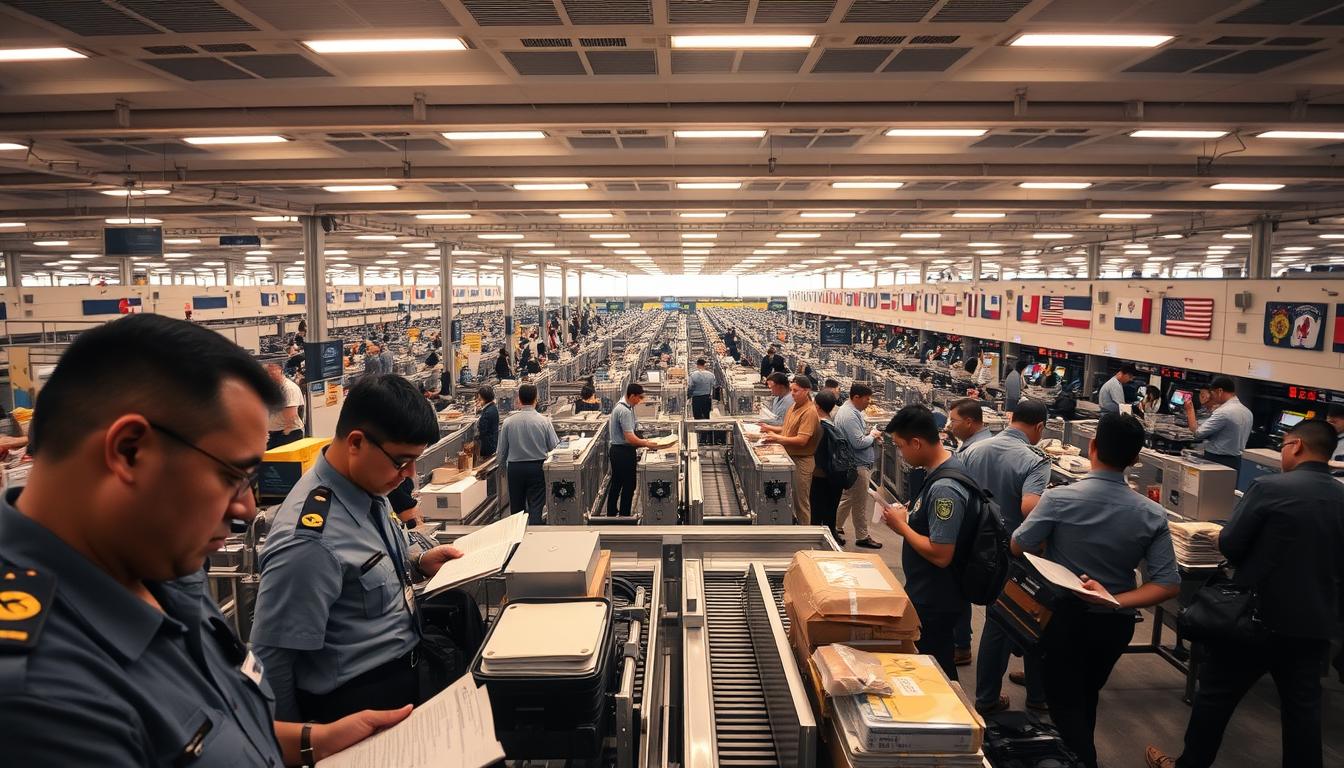Explore the key elements of effective international trade logistics services to optimize your supply chain.
In today’s globalized economy, the efficient movement of goods across borders is crucial. Global supply chain management has become increasingly complex, involving multiple stakeholders and requiring precise coordination.

International trade logistics services play a vital role in facilitating the smooth operation of global supply chains. These services enable businesses to navigate the complexities of international trade, ensuring timely and cost-effective delivery of goods.
Understanding the intricacies of global supply chain management and the role of logistics services is essential for businesses to remain competitive in the global market.
Key Takeaways
- Efficient global supply chain management is crucial in today’s economy.
- Logistics services facilitate the smooth operation of global supply chains.
- Understanding logistics services is key to remaining competitive.
- Global supply chains involve multiple stakeholders and require precise coordination.
- International trade logistics services enable timely and cost-effective delivery.
The Evolving Landscape of Global Trade Logistics
The global logistics landscape is transforming due to technological advancements and shifting economic landscapes. Companies must adapt to remain competitive.
Some of the key trends shaping international supply chains include the adoption of digital technologies, such as blockchain and artificial intelligence, to improve efficiency and transparency. Additionally, there is a growing emphasis on sustainability, with companies seeking to reduce their environmental impact.
Current Trends Shaping International Supply Chains
Trends include the adoption of digital technologies and a focus on sustainability. Companies are building resilience and agility in their supply chains.
The Economic Impact of Efficient Logistics
Efficient logistics improves profitability, reduces costs, and enhances customer satisfaction. Companies investing in logistics efficiency can see significant returns.
Core International Trade Logistics Services Explained
Efficient logistics are the linchpin of international trade, enabling the smooth transportation of goods worldwide. At the heart of these logistics are several core services that ensure the timely and secure delivery of products across borders.
Freight Forwarding and Cargo Management
Freight forwarding is a critical component of international trade logistics, involving the coordination and movement of goods from one place to another. This service is provided by freight forwarders who act as intermediaries between the shipper and various transportation services.
Door-to-Door Services
One of the key benefits of freight forwarding is the availability of door-to-door services, where the freight forwarder handles the entire shipping process, from picking up the cargo at the shipper’s doorstep to delivering it to the consignee’s doorstep. This comprehensive service simplifies the shipping process for businesses.
Consolidation Benefits
Another significant advantage is cargo consolidation, which involves combining multiple shipments into a single consignment. This approach can lead to significant cost savings and more efficient use of transportation resources.
Customs Brokerage and Compliance
Navigating the complexities of customs regulations is a crucial aspect of international trade logistics. Customs brokerage services help ensure compliance with these regulations, facilitating the smooth clearance of goods through customs. This service is vital for avoiding delays and potential legal issues.
Warehousing and Distribution Networks
Efficient warehousing and distribution are essential for managing inventory and ensuring that products are delivered to the right place at the right time. Modern logistics providers offer sophisticated warehousing solutions, including inventory management and order fulfillment services, to support businesses in their supply chain operations.
Video source from youtube
Transportation Modes and Their Strategic Applications
The global trade landscape is shaped by various transportation modes, each with its strategic applications. Understanding these modes is crucial for businesses to optimize their logistics operations and meet their supply chain objectives.
Ocean Freight: Container and Bulk Shipping
Ocean freight remains a dominant mode for international trade, particularly for bulky or heavy shipments. Container shipping offers a versatile and efficient way to transport a wide range of goods, from consumer products to machinery. On the other hand, bulk shipping is ideal for commodities such as grains, coal, and oil, where large volumes are transported without packaging.
Air Freight: When Speed is Essential
Air freight is the preferred mode when speed is critical, such as for perishable goods, high-value items, or time-sensitive shipments. It offers rapid transit times, albeit at a higher cost compared to ocean freight. Express air freight services further enhance this by providing door-to-door delivery within a very short timeframe.
Land Transportation: Trucks and Rail Options
Land transportation, including trucks and rail, plays a vital role in connecting ports to inland destinations. Trucking offers flexibility and is suitable for shorter distances or last-mile deliveries. Rail transport, on the other hand, is efficient for longer distances, especially for heavy or bulky goods, providing a cost-effective alternative to trucking.
Multimodal Solutions for Complex Supply Chains
Multimodal transportation combines different modes (ocean, air, land) to create a seamless and efficient supply chain. This approach allows businesses to leverage the strengths of each mode, optimizing transit times, costs, and reliability. Multimodal solutions are particularly beneficial for complex supply chains that span multiple regions or involve various types of cargo.
In conclusion, the choice of transportation mode(s) significantly impacts the efficiency and effectiveness of international trade logistics. By understanding the strategic applications of each mode and leveraging multimodal solutions, businesses can enhance their supply chain operations and achieve their logistical goals.
Navigating Customs and Regulatory Requirements
Effective management of customs and regulatory requirements is essential for smooth international trade operations. Companies involved in global trade must understand and comply with various regulations to avoid delays and additional costs.
Critical Documentation for International Shipments
Proper documentation is crucial for clearing customs efficiently. The key documents required include:
Commercial Invoices and Packing Lists
A commercial invoice provides details about the transaction, including the value and description of goods. A packing list outlines the contents of each shipment, facilitating customs inspection.
Certificates of Origin and Other Specialized Documents
Certificates of origin verify the country where the goods were manufactured, which can affect tariffs and trade agreements. Other specialized documents may be required depending on the type of goods and their destination.
Customs Clearance Processes by Region
Customs clearance processes vary significantly across different regions. Understanding these regional differences is crucial for efficient logistics management.

Managing Tariffs, Duties, and Trade Agreements
Navigating tariffs, duties, and trade agreements is a complex aspect of international trade. Companies must stay informed about changes in trade policies to minimize costs.
| Trade Agreement | Description | Benefit |
|---|---|---|
| USMCA | United States-Mexico-Canada Agreement | Reduced tariffs on trade between the US, Mexico, and Canada |
| EU-Japan EPA | EU-Japan Economic Partnership Agreement | Elimination of tariffs on various goods traded between the EU and Japan |
By understanding and effectively managing customs and regulatory requirements, businesses can ensure compliance, reduce costs, and improve the efficiency of their international trade operations.
Digital Transformation in International Trade Logistics Services
Digital transformation is reshaping the landscape of international trade logistics, enhancing efficiency and transparency. This significant shift is driven by the need for faster, more reliable, and more secure logistics services in a global market.
The integration of advanced digital technologies is transforming traditional logistics practices, enabling businesses to better manage their supply chains. One of the key technologies driving this change is supply chain visibility platforms.
Supply Chain Visibility Platforms
Supply chain visibility platforms provide real-time tracking and monitoring of shipments, allowing businesses to have complete visibility over their goods as they move through the supply chain. This transparency helps in reducing delays, improving delivery times, and enhancing overall customer satisfaction.
Automation and AI in Logistics Management
Automation and Artificial Intelligence (AI) are playing an increasingly important role in logistics management. AI algorithms can predict potential disruptions, optimize routes, and streamline logistics operations, while automation technologies, such as robotics, are improving warehouse management and reducing manual errors.
Blockchain for Secure and Transparent Trade
Blockchain technology is being explored for its potential to secure and transparently facilitate international trade. By creating an immutable record of transactions, blockchain can help reduce fraud, improve compliance with regulations, and enhance trust among trading partners.
The adoption of these digital technologies is not just a trend but a necessity for businesses aiming to stay competitive in the global market. As international trade logistics continues to evolve, embracing digital transformation will be crucial for companies seeking to improve their supply chain resilience and efficiency.
Risk Management Strategies for Global Logistics
Managing risks is crucial in the complex world of international trade. Effective risk management enables companies to ensure the smooth operation of their global supply chains.
To manage risks effectively, companies must identify potential vulnerabilities in their supply chains. This involves assessing the likelihood and potential impact of disruptions such as natural disasters, geopolitical tensions, and cyberattacks.
| Risk Factor | Potential Impact | Mitigation Strategy |
|---|---|---|
| Natural Disasters | Supply chain disruptions, inventory loss | Diversify suppliers, develop emergency response plans |
| Geopolitical Tensions | Trade restrictions, tariffs, and taxes | Monitor geopolitical developments, develop contingency plans |
| Cyberattacks | Data breaches, system downtime | Implement robust cybersecurity measures |
Cargo insurance is a critical component of risk management. Companies should consider purchasing cargo insurance to protect against loss or damage during transit.
Developing contingency plans is also essential. Companies should identify potential risks and develop alternative scenarios to respond to disruptions.
Selecting and Managing Logistics Service Providers
As global trade continues to evolve, the importance of selecting and managing the right logistics service providers cannot be overstated. Effective logistics management is crucial for maintaining a competitive edge in the international market.

Evaluating 3PL, 4PL, and 5PL Service Models
The logistics industry offers various service models, including Third-Party Logistics (3PL), Fourth-Party Logistics (4PL), and Fifth-Party Logistics (5PL). 3PL providers offer specific services such as transportation, warehousing, and freight forwarding. In contrast, 4PL providers act as integrators, managing multiple logistics services and providing a comprehensive supply chain solution. 5PL providers take it a step further by leveraging advanced technologies and data analytics to optimize logistics operations.
| Service Model | Key Features | Benefits |
|---|---|---|
| 3PL | Transportation, Warehousing, Freight Forwarding | Specialized services, cost-effective |
| 4PL | Integrated supply chain management | Comprehensive solutions, improved efficiency |
| 5PL | Advanced technology, data analytics | Optimized logistics, data-driven insights |
Key Performance Indicators for Logistics Partners
Establishing key performance indicators (KPIs) is essential for evaluating the performance of logistics service providers. Common KPIs include on-time delivery rates, shipment accuracy, and inventory management efficiency. By monitoring these metrics, businesses can ensure their logistics partners meet the required standards.
“The key to successful logistics management lies in the ability to measure and analyze performance accurately.” – Logistics Expert
Building Collaborative Relationships with Providers
Developing collaborative relationships with logistics service providers is vital for mutual success. This involves regular communication, joint planning, and mutual goal setting. By fostering a collaborative environment, businesses can improve supply chain resilience and achieve better outcomes.
In conclusion, selecting and managing logistics service providers requires careful evaluation of service models, establishment of KPIs, and development of collaborative relationships. By following these guidelines, businesses can optimize their logistics operations and maintain a competitive edge in the global market.
Cost Optimization in International Logistics Operations
Optimizing costs in international logistics is crucial for businesses to remain competitive in the global market. One of the key strategies involves understanding and understanding the total landed cost, which encompasses all expenses associated with getting a product from the supplier to the customer.
Total Landed Cost Analysis
Total landed cost includes all expenses associated with the purchase, transportation, and storage of goods. Analyzing these costs helps businesses identify areas for cost reduction.
Inventory and Warehousing Cost Reduction
Reducing inventory and warehousing costs can be achieved through efficient supply chain management. Implementing just-in-time inventory systems and optimizing warehouse layouts can minimize storage costs and maximize efficiency.
Conclusion: Future-Proofing Your International Trade Logistics Strategy
As global trade continues to evolve, businesses must prioritize future-proofing their logistics operations to remain competitive. This involves staying adaptable in the face of changing consumer demands, technological advancements, and shifting global trade dynamics.
A well-planned international trade logistics strategy is crucial for navigating these complexities. By leveraging the latest technologies, such as supply chain visibility platforms and blockchain, businesses can enhance their logistics operations and improve overall efficiency.
To future-proof logistics, companies must continually assess and improve their operations, identifying areas for cost optimization and implementing robust risk management strategies. By doing so, businesses can ensure they are well-positioned to respond to emerging trends and challenges in the global market.
By adopting a proactive approach to international trade logistics, businesses can drive growth, improve customer satisfaction, and maintain a competitive edge in an increasingly complex global landscape.
FAQ
What are the key components of international trade logistics services?
International trade logistics services encompass a range of activities, including freight forwarding, customs brokerage, warehousing, and transportation management, all designed to facilitate the smooth movement of goods across global borders.
How do digital technologies impact global supply chains?
Digital technologies, such as supply chain visibility platforms, automation, and AI, enhance logistics management by improving efficiency, reducing costs, and increasing transparency, thereby revolutionizing the way businesses manage their global supply chains.
What is the significance of customs compliance in international trade?
Customs compliance is crucial in international trade as it ensures that shipments clear customs efficiently, minimizing delays and costs associated with non-compliance, such as tariffs, duties, and potential penalties.
How can businesses optimize their logistics costs?
Businesses can optimize their logistics costs by employing total landed cost analysis techniques, reducing inventory and warehousing costs, and leveraging technology for efficiency gains, ultimately minimizing their logistics expenses without compromising service quality.
What are the benefits of using multimodal transportation solutions?
Multimodal transportation solutions, which combine different transportation modes, offer flexibility, efficiency, and cost-effectiveness, enabling businesses to manage complex supply chains more effectively and respond to changing market demands.
How can companies mitigate risks in their global supply chains?
Companies can mitigate risks in their global supply chains by identifying and assessing vulnerabilities, considering cargo insurance and liability, and developing robust contingency plans to address potential disruptions, such as natural disasters or geopolitical tensions.
What role does blockchain play in international trade logistics?
Blockchain technology has the potential to secure and transparently facilitate international trade by providing a decentralized, immutable ledger that tracks transactions and movements, enhancing trust and reducing the risk of fraud and errors.
How do businesses select the right logistics service provider?
Businesses select the right logistics service provider by evaluating different service models, such as 3PL, 4PL, and 5PL, establishing key performance indicators (KPIs) for logistics partners, and building collaborative relationships to ensure mutual benefit and success.

